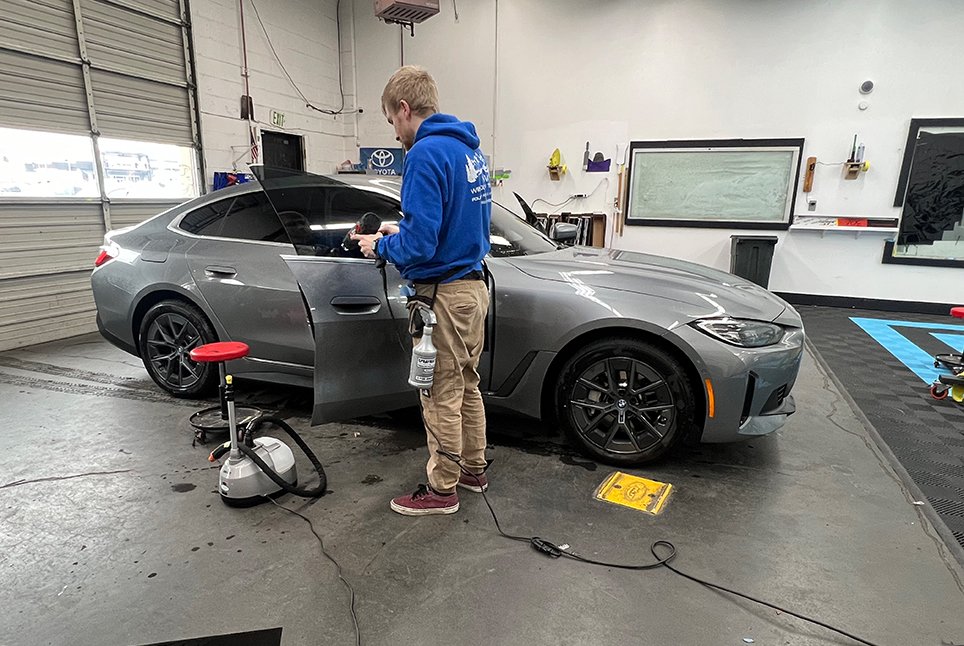Window Tinting Laws and Guidelines: What You Required to Know Before Tinting Your Vehicle
Prior to proceeding with window tinting for your lorry, it is vital to acquaint on your own with the varied legislations and guidelines that govern this practice throughout different states. These regulations determine the permitted levels of color darkness, usually measured by noticeable light transmission (VLT) percents, and include particular stipulations for front windscreens aimed at ensuring road safety.
Overview of Window Tinting Rules
Home window tinting regulations are frequently based on variation across different jurisdictions, showing regional laws and safety considerations. These legislations determine the acceptable levels of color darkness and reflectiveness on vehicle home windows, making sure that chauffeurs preserve ample visibility while additionally shielding versus harmful UV rays and warm.
A lot of laws classify window tinting based upon the Visible Light Transmission (VLT) percent, which shows the quantity of light that can pass via the window. Generally, lower VLT percents represent darker colors. Legislations often separate in between the front, side, and back windows, with stricter restrictions used to the front windshield to improve security for both the chauffeur and other roadway customers.
Conformity with home window tinting regulations is essential, as infractions can result in fines, necessary removal of the tint, and possible increases in insurance coverage premiums. It is crucial for automobile proprietors to acquaint themselves with neighborhood legislations prior to proceeding with window tinting setups.
State-by-State Color Laws
Comprehending the details home window tinting policies in each state is vital for car proprietors seeking to adhere to the legislation. Each state in the U.S. has established its very own set of guidelines regulating home window tinting, which can differ significantly. These guidelines often dictate the permitted levels of tint darkness, the kinds of home windows that can be tinted, and any kind of clinical exceptions that may apply.
As an example, states like California have stringent constraints on color darkness for front windows, while others, such as New Mexico, may allow darker colors. Furthermore, particular states mandate details visibility percentages for numerous home windows, consisting of the windscreen, front side home windows, and rear home windows. It is crucial for car proprietors to familiarize themselves with their state's laws to prevent prospective penalties or charges.
Additionally, some states might call for an accreditation sticker to be positioned on tinted windows, showing conformity with state laws. Failing to adhere to these laws not only takes the chance of legal effects however can also affect security and visibility while driving. Consequently, lorry proprietors need to conduct complete research study or consult regional authorities to guarantee complete understanding and compliance with state-by-state tint regulations.
Allowed Color Kinds and levels
Several lorry owners might be shocked to learn that enabled tint degrees and kinds vary extensively across various states. Each state has actually established its very own regulations relating to the acceptable darkness and reflectivity of window tint, typically measured by Visible Light Transmission (VLT) percentages. VLT describes the amount of light that can pass with the tinted home windows; thus, a lower portion shows a darker color.

In addition, the kinds of tint products allowed can differ, with some states forbiding metal or mirror-like surfaces. It is crucial for car owners to acquaint themselves with their state's Read Full Article particular regulations to guarantee compliance. Non-compliance can cause fines, required elimination of the tint, or various other lawful consequences, making it imperative to understand these guidelines prior to waging setup.
Medical Exemptions for Tinting
While not all states give allocations for medical exemptions regarding home window tinting, those that do recognize the necessity for certain individuals to enhance visibility and convenience because of clinical conditions. Numerous clinical conditions, such as lupus, skin cancer cells, and certain eye problems, can provide individuals particularly conscious sunshine. Consequently, these individuals might require darker colors to safeguard themselves from damaging UV rays and glare.

It is essential to note that despite having a medical exception, there might still be restrictions on the degree of tint allowed. Conformity with state laws ensures that people are both secured and within lawful restrictions. Those thinking about medical exemptions must contact their regional Division of Electric motor Vehicles or equal authority to recognize the procedures and needs essential to look for an exception efficiently.
Fines for Non-Compliance
Failing to adhere to window tinting laws can cause considerable fines, which vary by state. Police are encouraged to provide citations for automobiles that do not abide by the defined tinting regulations. These fines usually include fines, which can range from moderate quantities to numerous hundred dollars, relying on the severity of the infraction and the state concerned.
In some jurisdictions, repeated offenses may lead to escalating penalties or additional fines, such as compulsory court appearances. Non-compliance may demand the removal of unlawful tinting, typically at the owner's expense. In extreme instances, regular culprits might deal with suspension of their vehicle enrollment up until conformity is accomplished.
In addition, insurance effects might arise from getting numerous citations for from this source window color offenses. Insurance providers may see such violations as a sign of riskier actions, possibly resulting in enhanced premiums or difficulty in insurance coverage.
To prevent these charges, it is important for car proprietors to familiarize themselves with their neighborhood window tinting laws and make certain that their vehicle complies (Window Tinting). This proactive approach not just prevents legal ramifications but also promotes road safety
Verdict

Most policies identify window tinting based on the Visible Light Transmission (VLT) portion, which indicates the quantity of light that can pass via the window. Conformity with home window tinting regulations is crucial, as infractions can result in fines, compulsory elimination of the color, and potential boosts in insurance coverage premiums.Recognizing the certain window tinting guidelines in each state is essential for vehicle owners seeking to conform with the legislation. These regulations usually dictate the permitted levels of color darkness, the kinds of windows that can be tinted, and any clinical exemptions that might apply.
For circumstances, states like The golden state have strict constraints on color darkness for front home windows, while others, such as New Mexico, may allow darker colors.